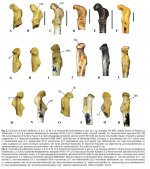Fred Ruhe
Well-known member

Nikita V. Zelenkov & Andrey V. Panteleyev, 2019
A small stem-galliform bird (Aves: Paraortygidae) from the Eocene of Uzbekistan
Comptes Rendus Palevol. in press
doi:10.1016/j.crpv.2019.04.005
Abstract: https://www.sciencedirect.com/science/article/pii/S1631068319300909?via=ihub
Landfowl (order Galliformes) are among the most characteristic birds of the modern avian faunas, but their early evolutionary history is insufficiently known. The diversity of previously described Eocene galliforms implies a great role of Eocene diversification in the early evolution of this group. However, almost nothing is known about the Eocene diversity of galliforms in Asia, even though this large continent with a variety of habitats might have played a significant role in their early evolution. Here we describe a partial coracoid from the Lutetian–Bartonian of Uzbekistan, which is the oldest diagnosable galliform bird in Asia, and is further the first landbird known from this geographical area. The specimen displays a unique morphology with few autapomorphies and an unexpected combination of similarities with the African genus Scopelortyx and Eurasian Paraortyx, and hence is described as a new taxon, Xorazmortyx turkestanensis gen. et sp. nov., within the extinct family Paraortygidae, being the first Asian representative of this clade. Similarities with the African genus Scopelortyx indicate a connection of land bird faunas between northern Africa/Arabia and Asia in the middle Eocene. Better dispersal abilities of the early galliforms Paraortygidae are inferred from the osteology of their pectoral girdle and the humerus, which do not show adaptations to the powerful burst take off (escape flight), characteristic of most modern Phasianidae.
Enjoy,
Fred
A small stem-galliform bird (Aves: Paraortygidae) from the Eocene of Uzbekistan
Comptes Rendus Palevol. in press
doi:10.1016/j.crpv.2019.04.005
Abstract: https://www.sciencedirect.com/science/article/pii/S1631068319300909?via=ihub
Landfowl (order Galliformes) are among the most characteristic birds of the modern avian faunas, but their early evolutionary history is insufficiently known. The diversity of previously described Eocene galliforms implies a great role of Eocene diversification in the early evolution of this group. However, almost nothing is known about the Eocene diversity of galliforms in Asia, even though this large continent with a variety of habitats might have played a significant role in their early evolution. Here we describe a partial coracoid from the Lutetian–Bartonian of Uzbekistan, which is the oldest diagnosable galliform bird in Asia, and is further the first landbird known from this geographical area. The specimen displays a unique morphology with few autapomorphies and an unexpected combination of similarities with the African genus Scopelortyx and Eurasian Paraortyx, and hence is described as a new taxon, Xorazmortyx turkestanensis gen. et sp. nov., within the extinct family Paraortygidae, being the first Asian representative of this clade. Similarities with the African genus Scopelortyx indicate a connection of land bird faunas between northern Africa/Arabia and Asia in the middle Eocene. Better dispersal abilities of the early galliforms Paraortygidae are inferred from the osteology of their pectoral girdle and the humerus, which do not show adaptations to the powerful burst take off (escape flight), characteristic of most modern Phasianidae.
Enjoy,
Fred




